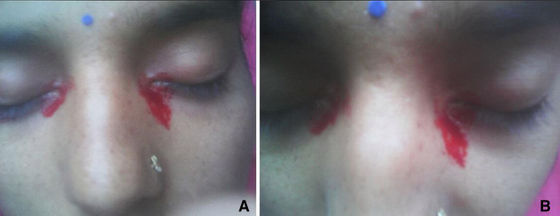Rare cases of 'bloody tears' appearing during menstruation are reported

by
The idiom 'Tears of Blood' refers to 'tears that overflow with anger and sadness,' and does not mean that blood actually flows out of the eyes like tears. However, a new report has been made of a woman with an idiosyncratic constitution in which the literal 'tears of blood' flow out during menstruation.
Woman cries blood tears during menstruation in'rare and unusual clinical case' | Live Science
https://www.livescience.com/blood-tears-menstruation.html
Tears are blood obtained from the capillaries in the lacrimal gland, with blood cells removed and only the liquid component extracted. The components are almost the same as blood. Reports of 'blood flowing from the eyes' are often treated like fake, but multiple cases of blood tears due to bacterial conjunctivitis or trauma have been confirmed so far, and the disease name 'Haemolacria ' also exists. To do.
A person who really shed 'tears of blood' is reported --GIGAZINE

The cases reported by Soumitra Ghosh et al. Of the Chandigarh Graduate School of Medical Education (PGIMER) in India were particularly rare because the blood that flowed out of the eyes literally looked like 'blood itself' and was caused by menstruation. It was the point that it was triggered. Haemolacria, which has been reported so far, is often caused by diseases and injuries such as bacterial conjunctivitis and trauma as mentioned above, and the blood that flows out is 'pure blood' that is a mixture of normal tears and blood. Most of them were far away. Therefore, this case is reported to be particularly rare.
The actual image is below. The patient was a 25-year-old woman who had no abnormalities in the eyes, sinuses, lacrimal ducts, or tears of blood, despite shedding blood. Furthermore, when shedding tears of blood, she did not have any health problems such as headache or dizziness.

Previous cases have shown that common causes of Haemolacria are inflammation, trauma, lesions, tumors, hypertension, jaundice and anemia. However, Ghosh and colleagues diagnosed the woman for the above common causes, and found that the case was cyclical from areas other than the uterus, such as the nose, ears, lungs, nipples, intestines, skin, and eyes. I was diagnosed with compensatory menstruation that caused bleeding.
The most common form of compensatory menstruation is 'nosebleed', which is bleeding from the nasal mucosa, accounting for about 30%. According to the interview, the woman in question answered that she had nosebleeds when she shed tears of blood for the first time, and it is considered that there is a high possibility of compensatory menstruation.
It is known that certain eye tissues are affected by hormonal balance, and the curve and thickness of the cornea may change during menstruation, pregnancy, and lactation, so Ghosh said this phenomenon is hormonal balance. Prescribes oral contraceptives to the woman in question. After continuing this hormone therapy for 3 months, he stopped shedding bloody tears.
Regarding this phenomenon, Ghosh pointed out in a treatise that 'it is a rare case that has not been described in recent medical literature.' Although the administration of oral contraceptives helped for the time being, 'further research is needed to accurately understand the cause of blood tears and manage their condition in the long term and efficiently.'
Related Posts:
in Science, Posted by darkhorse_log






